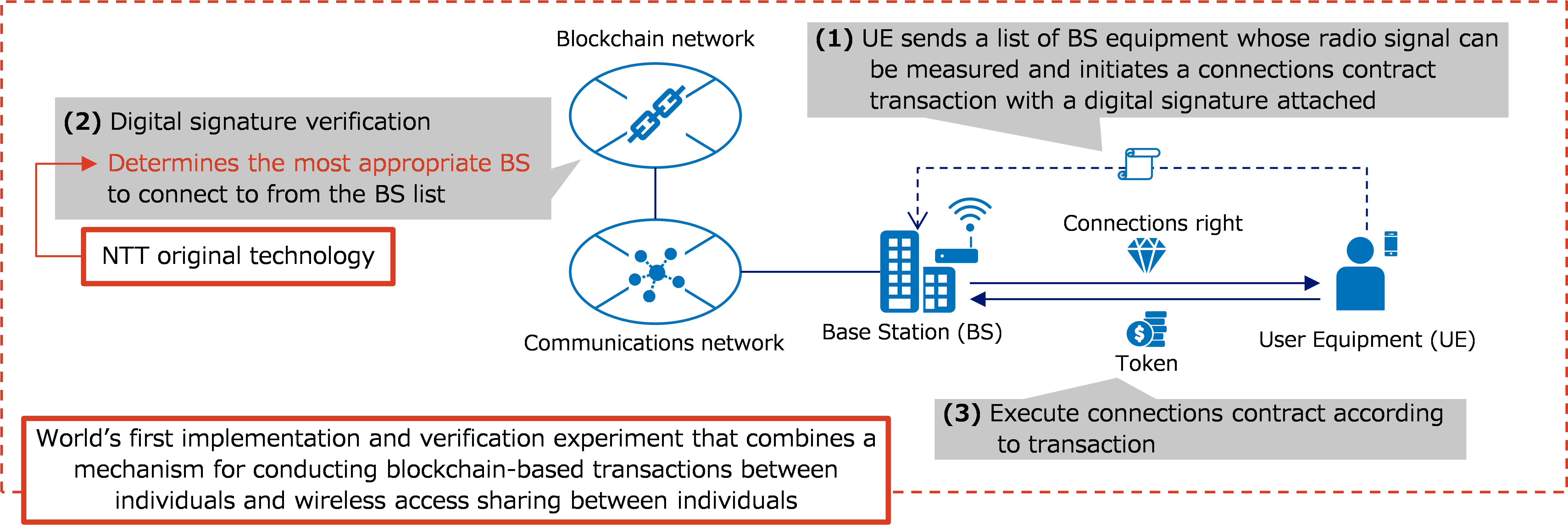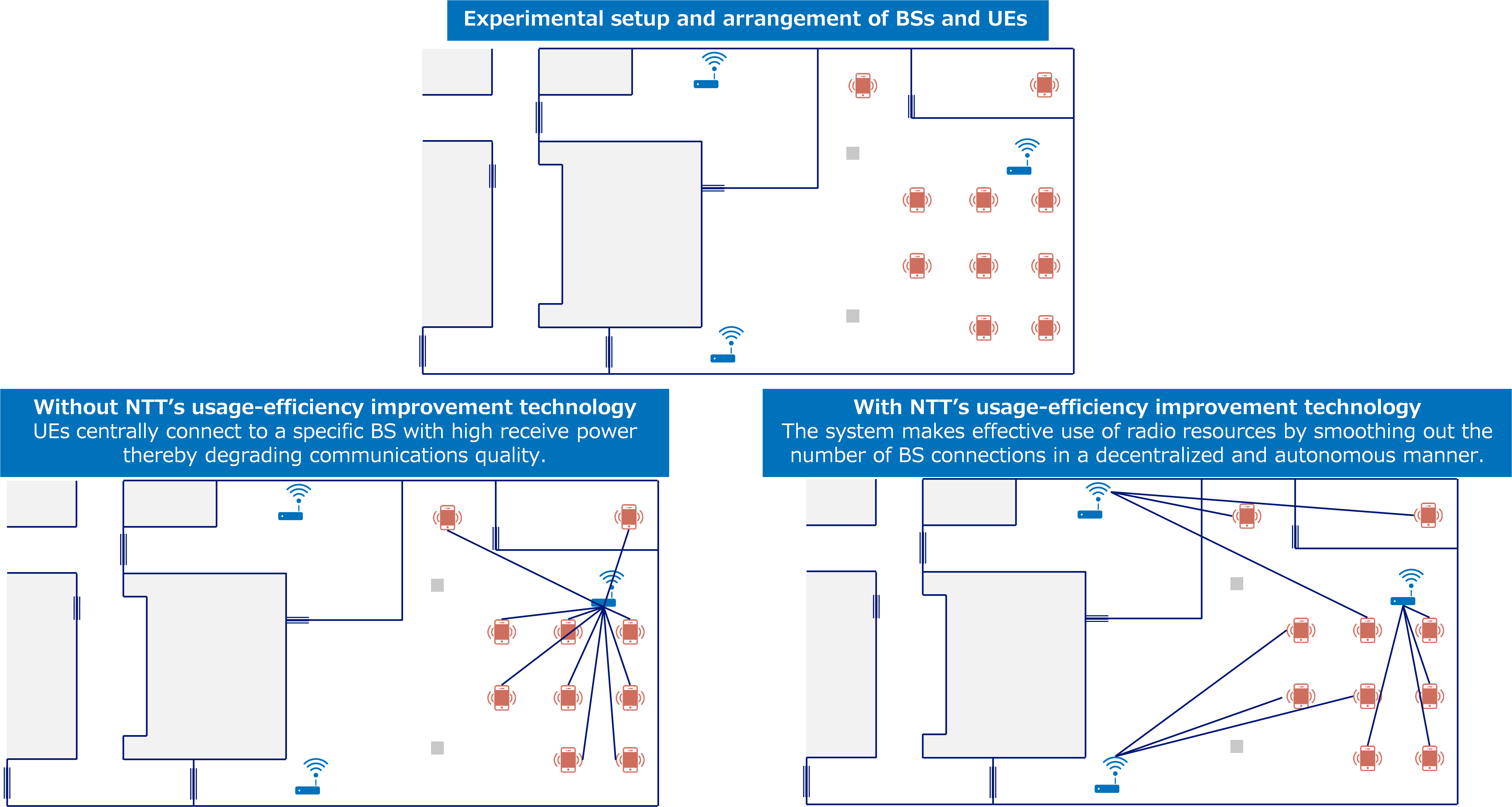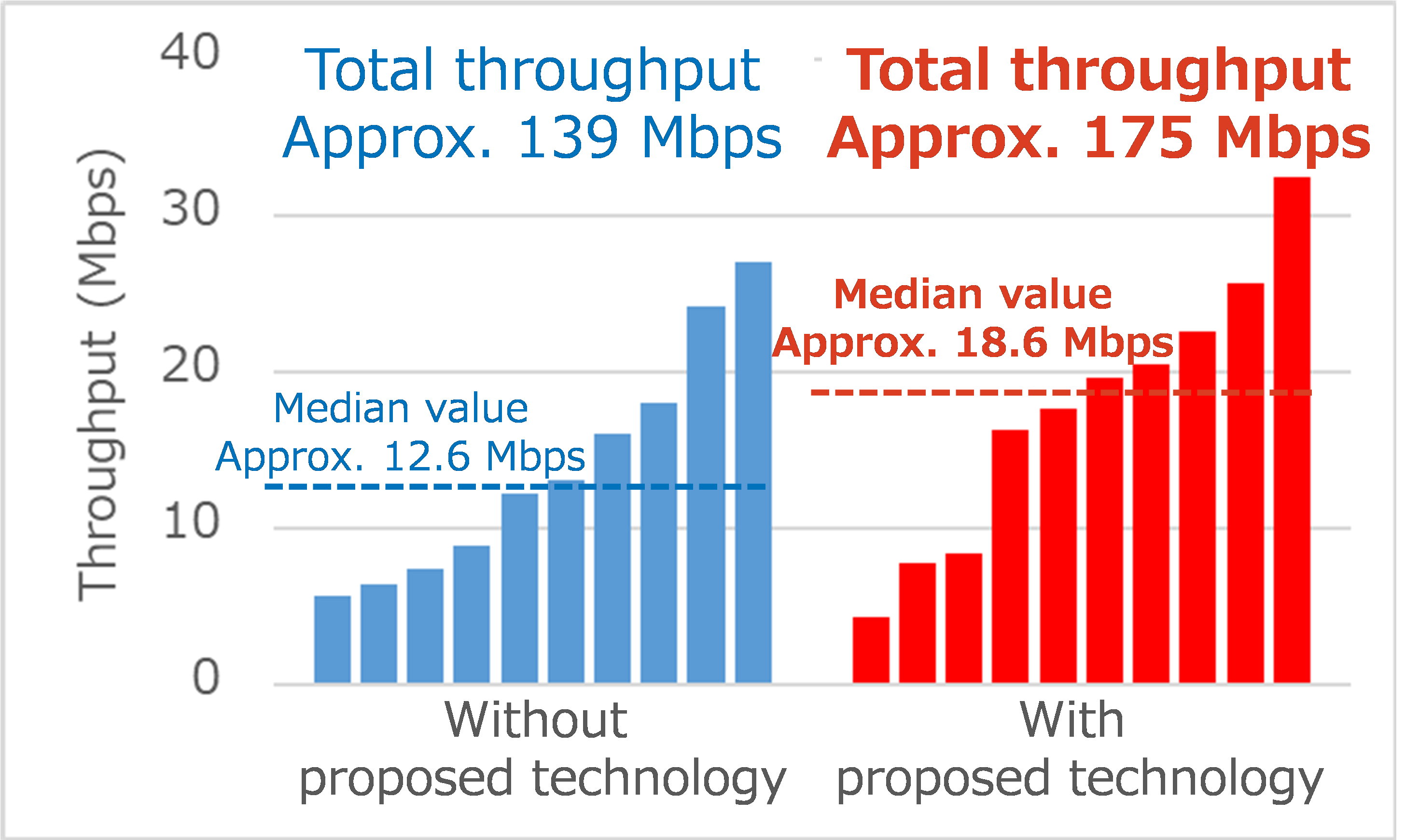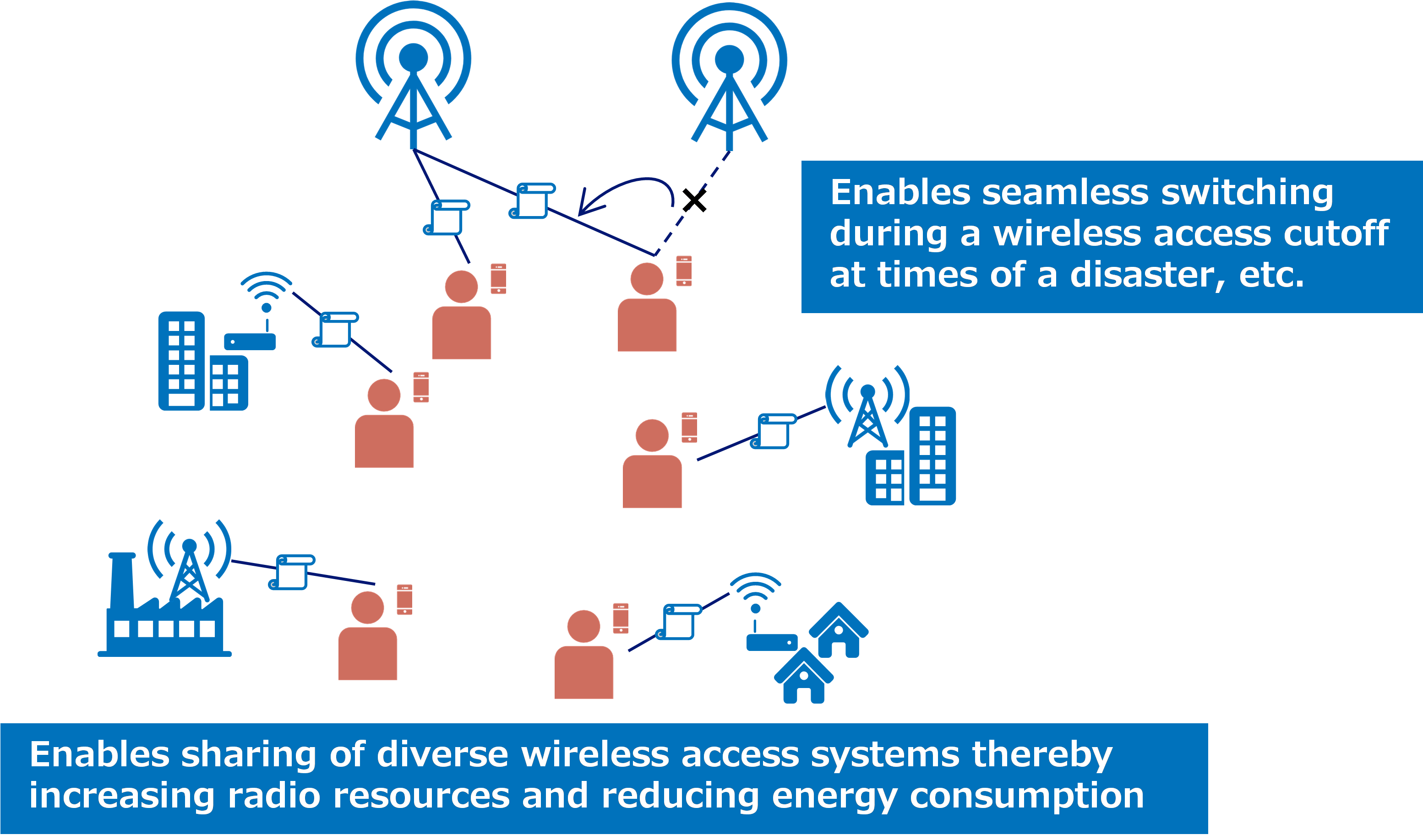Microsoft ends support for Internet Explorer on June 16, 2022.
We recommend using one of the browsers listed below.
- Microsoft Edge(Latest version)
- Mozilla Firefox(Latest version)
- Google Chrome(Latest version)
- Apple Safari(Latest version)
Please contact your browser provider for download and installation instructions.
April 26, 2023
NTT Corporation
World's First Successful Verification Experiment of Wireless Access Sharing Technology using Blockchain
-Contributes to ICT Resource Sharing between Individuals Leading to Reduced Facility Costs and Power Consumption across Society-
NTT Corporation (Headquarters: Chiyoda-ku, Tokyo, President & CEO: Akira Shimada, "NTT") has successfully conducted the world's first*1 verification experiment of wireless access sharing technology between individuals using blockchain enabling anyone to use wireless access equipment installed everywhere via a one-time contract.
This technology combines blockchain technology emphasized by Web3 and wireless access technology to solve the issues of incentives, security, and costs in relation to wireless access sharing. It will enable the sharing of wireless access between individuals, which has traditionally been difficult, and in contrast to the current scheme that enables wireless LAN to be used only with one's own wireless LAN setup or with a contracted Wi-Fi service or cellular line, it is expected to enable anyone to connect to a nearby wireless access system for communication purposes. This technology will also enable wireless access sharing without a drop in communications quality thereby providing a countermeasure to future increases in traffic, and it has the potential of creating a highly efficient wireless access network across society. These features should lead to a reduction of facility costs and power consumption throughout society.
NTT's wireless access sharing technology will be introduced at Tsukuba Forum 2023*2 scheduled to be held on May 17 (Wednesday) and May 18 (Thursday), 2023.
1. Background
Wireless traffic is estimated to increase by approximately 80 times by 2030 relative to 2020*3 and to continue this upward trend into the future. Such an increase in traffic can result in congestion and connection failures, and to prevent this from happening, it will be necessary not only to enhance individual wireless access systems but also to secure radio resources for processing all wireless traffic. One method for securing the radio resources needed is to install more radio base stations as wireless access facilities on a grand scale, but a method that constructs all of the wireless access facilities needed to accommodate wireless traffic 80 times greater than the present will inevitably drive up costs.
To solve this problem, it is important that radio resources be effectively used including private wireless access systems such as wireless LAN and local 5G owned by individuals and companies. Here, the sharing of such wireless access systems is one means of effectively using radio resources. However, in conventional wireless access sharing, a variety of issues such as how to provide incentives to wireless access providers, how to ensure security in relation to sharing, and how to reduce the costs incurred in system construction must be solved. In addition, other problems arise even if wireless access sharing can be achieved. For example, if wireless access systems owned by a variety of parties are being shared, such systems will be individually operated instead of being centrally controlled, which means that users will end up connecting to wireless access systems with good communications quality in a concentrated manner generating congestion. Such an outcome will produce new problems such as a drop in the usage efficiency of radio resources and degraded communications quality for wireless access overall.
Solving the above problems to promote wireless access sharing should lead to more effective use of wireless access throughout society. For example, it is estimated that approximately 5 million wireless LAN access points are operating in Tokyo's 23 wards, but from the viewpoint of coverage, approximately 20 times more access points than needed are already installed by individuals or corporate entities for their exclusive use*4. Consequently, if the approximately 4.75 million surplus access points can be shared, it should be possible to deal with future increases in wireless traffic with minimal wireless facilities and power consumption.
2. Technical features
Using blockchain technology emphasized by Web3 in combination with wireless access will enable anyone to use wireless access systems owned by all sorts of individuals and companies via a one-time contract. The main features of this wireless access sharing technology are summarized below.
- Provides incentives in the form of contract income to wireless access providers through connection contracts
- Achieves secure sharing through blockchain-provided security functions
- Reduces cost of constructing a shared system since a decentralized autonomous blockchain system negates the need for centralized control stations
- Enables each radio base station to use blockchain-ledger information to smooth out the number of terminal connections in a decentralized and autonomous manner and improve communications quality (technology for improving use of radio resources)
The verification experiment tested this wireless access sharing technology based on blockchain while also evaluating its effect in improving the usage efficiency of radio resources.
3. Results of verification experiment
Based on the results of this verification experiment, anyone will be able to conclude a one-time contract and use wireless access systems owned by all sorts of individuals and companies.
The flow for concluding a connections contract with this technology in this verification experiment is shown in Fig. 1.
First, in step (1), User Equipment (UE) provides a list of surrounding radio Base Station (BS) equipment whose radio signal can be measured along with its own digital signature and initiates a connections contract transaction. The transaction is sent to a temporarily connected BS, but a BS for which a connections contract has already been concluded or a communications line outside of this technology (such as a public cellular line) may also be used.
Next, in step (2), the digital signature is verified on the blockchain network to verify the user's identity and prevent impersonation as well as to ensure the absence of fraud such as an alteration of the request. At this time, the degree of congestion at each BS in the list sent by the UE is also referenced to determine the most appropriate connection destination (contract destination). The BS and UE are then notified of this result. This series of operations is executed through a smart contract protocol on the blockchain.
In step (3), the connections contract is executed between the BS and UE based on the results of step (2), the BS provides communications, and the UE executes payment for the connection.
This is the world's first attempt at implementing such a mechanism for conducting blockchain-based transactions between individuals in combination with wireless access sharing between individuals and at conducting a validation experiment. In addition, the portion that determines the most appropriate connection destination (contract destination) in step (2) of the flow for concluding a connections contract is NTT original technology.
In this verification experiment, we implemented the proposed technology using Ethereum-PoA*5*6, but it may be implemented using other blockchain platforms.
 Fig. 1 Outline of flow for concluding a connections contract using blockchain
Fig. 1 Outline of flow for concluding a connections contract using blockchain
The setup for the verification experiment is shown in Fig. 2. In this setup, we implemented the flow for concluding a connections contract shown in Fig. 1 using three BSs and ten UEs. Each BS and UE has a different administrator. We showed that this technology enabled each UE to perform communications through a one-time contract in an environment with a mixture of wireless access systems having different administrators.
We also examined the effect of NTT's original radio-resource usage-efficiency improvement technology. When simply making a BS-UE connection by a one-time contract, the UEs centrally connect to a specific BS with high receive power as shown at the bottom left of Fig. 2. This results in BS congestion and a drop in the usage efficiency of radio resources thereby degrading communications quality. On the other hand, NTT's original radio-resource usage-efficiency improvement technology makes it possible to use the connections contract history on the blockchain ledger to reference the number of UE connections and state of congestion at each BS. It also controls the connections contract fee to be higher at congested BSs and lower at non-congested BSs. In this way, if UEs simply select a BS with a lower connections contract fee, congestion will effectively be eliminated and radio-resource usage efficiency will improve for wireless access overall. As shown at the bottom right of Fig. 2, this technology can smooth out the number of BS connections in a decentralized and autonomous manner and make effective use of radio resources. Throughput for all UEs with and without radio-resource usage-efficiency improvement is shown in Fig. 3. It can be seen that this technology improves overall UE throughput.
 Fig. 2 Verification experiment setup and results of BS connections with/without radio-resource usage-efficiency improvement technology
Fig. 2 Verification experiment setup and results of BS connections with/without radio-resource usage-efficiency improvement technology
 Fig. 3 Effect of radio-resource usage-efficiency improvement technology
Fig. 3 Effect of radio-resource usage-efficiency improvement technology
4. Future outlook
The wireless access sharing technology proposed here is expected to provide a variety of benefits to society as a whole. These include a more comfortable experience for users of wireless facilities through an increase in available wireless access systems, increase in income for providers of wireless facilities through sharing, and reduction in wireless-facility investment costs, power consumption, and radio-wave interference throughout society thanks to sharing. We expect further advances in this technology to help solve energy issues through the effective use of surplus radio resources while reducing investment costs for wireless access facilities. We also expect that the application of this technology to wireless access cutoffs at the time of a disaster will enable seamless transitions to other wireless access systems thereby providing uninterrupted network services at such times (Fig. 4).
A variety of issues exist in achieving wireless access sharing between individuals such as conformance with laws and regulations dealing with facility sharing. However, with this technology, we aim to achieve new wireless access sharing of the future by providing incentives to wireless access providers as one format for solving issues and forming an economic zone. While this has been difficult to achieve by conventional economic principles, we expect Web3 to make it feasible. We will continue our studies with the goal of establishing this technology by FY2024.
 Fig. 4 Future outlook
Fig. 4 Future outlook
<glossary>
*1As of May 15, 2023, based on an NTT survey.
*2Tsukuba Forum 2023
https://www.tsukuba-forum.jp/
https://www.tsukuba-forum.jp/e/index.html (English)
*3From ITU-R Report M.2370-0 "IMT traffic estimates for the years 2020 to 2030."
https://www.itu.int/pub/R-REP-M.2370-2015
*4Based on NTT Estimates from Ministry of Internal Affairs and Communications (MIC): "Current Status of Wireless LAN Market," MIC: "Questionnaire Targeting Wireless LAN Users," IDC Japan: "Network Equipment Market Forecast for Domestic Enterprises, 2022-2026" (in Japanese).
https://www.soumu.go.jp/main_content/000846977.pdf
https://www.soumu.go.jp/main_content/000756068.pdf
https://www.idc.com/jp/research/report-list?search=JPJ47865122
*5Ethereum
A blockchain platform.
*6PoA (Proof of Authority)
A consensus algorithm used in a blockchain.
Media Contact
NTT Information Network Laboratory Group
Planning Department, Public Relations Section
nttrd-pr@ml.ntt.com
Information is current as of the date of issue of the individual press release.
Please be advised that information may be outdated after that point.
NTT STORY
WEB media that thinks about the future with NTT










